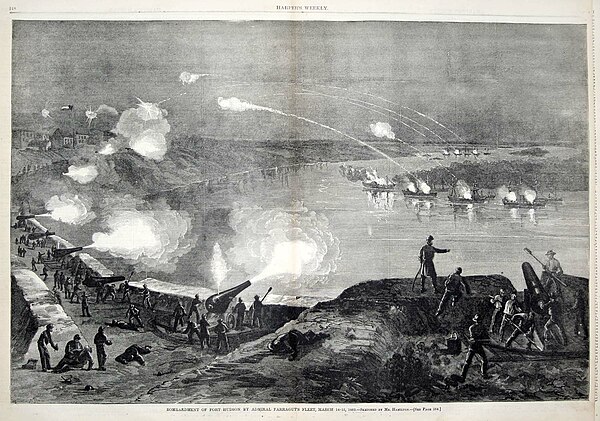 |
| Farragut |
Vicksburg was no longer the only remaining Confederate stronghold on
the Mississippi. Realizing the importance of the river, the
Confederates had fortified Port Hudson to the south. On a strong
bluff overlooking the river, it was a formidable position. Lincoln
sent new forces under Major General Nathaniel P. Banks to attack the
town. Banks was a political general with little military experience,
and he spent much time reorganizing the army to his liking.
 |
| Gun at Port Hudson |
While Banks remained in New Orleans, Rear Admiral David Farragut set
out up the river with seven ships. He planned to run the batteries
late on the night of Marcy 14, 150 years ago today. Extensive
preparations were undertaken to prepare the ships for battle. The
first four ships were tied together in pairs, proceeding one after
another up the river. The decks were cleared for action and
whitewashed, to improve visibility. Chains were draped down the
sides, serving as armor. The Confederates were ready and waiting,
having noticed increased naval movements downriver. They had 20 guns
in eleven batteries, with the crews well instructed of the plans
beforehand. Heated shot was prepared to try to light the wooden
ships, and outposts were established to give warning of the advance.
It was one of these outposts that sighted the Union fleet, launching
a warning rocket into the air at 11:20 pm on March 14. Farragut's
fleet continued on straight ahead, and opened on the Confederate
batteries as soon as they came in range. The darkness was lit by
fires on shore, but the river was again clouded as the guns billowed
forth their thick smoke. The Hartford and Albatross,
the lead ships, ran aground in the darkness right beneath the
Confederate batteries. Although they were stuck there for ten
minutes, they were able to make it out relatively unharmed.
The Genesee and Richmond came next. A gust of wind blew
away the smoke long enough for the rebel batteries to catch sight of
the ships and pour a murderous fire into the Richmond. Shots
tore through both her boiler safety valves, rendering her engines
useless. Unable to move, she and the Genesee floated
downstream with the current. The Monogahela and Kineo,
coming up next, also ran aground, and the two ships came apart. The
Monogahela damaged her engine in backing off, and the Kineo
took a shot to the rudder. Both ships floated down stream.
 |
| USS Mississippi |
The last Union ship was the Mississippi. She too ran aground,
and the Confederate batteries riddled her with hot shot. Catching on
fire, the captain ordered her to be abandoned, fearing the magazine
would explode. Loud were the cheers of the garrison as the ship
floated downstream at 3 am, a burning wreck. She blew up two hours
later in a huge explosion, seen 80 miles away in New Orleans. This
battle was a great victory for the Confederate garrison. They had
disabled four of the ships, destroyed one completely, with only two
successfully running the batteries. They lost only three men killed
and 22 wounded, versus 78 killed and 35 wounded from Farragut.




0 comments:
Post a Comment